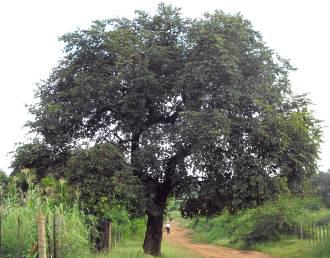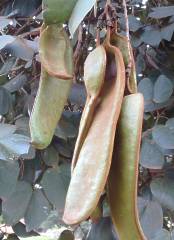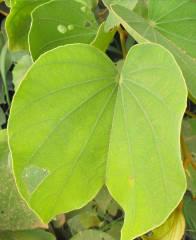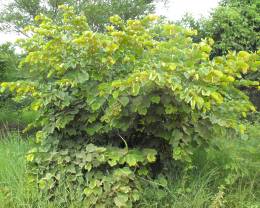Piliostigma thonnigii
Piliostigma thonningii (Schumach.) Milne-Redh.
Family: Fabaceae
Common names: camel's foot (Eng.); kameelspoor (Afr.); mukolokote (Venda); mokgoropo (North Sotho); nkolokotso (TS)
SA Tree No: 209
Introduction
This is a deciduous tree suitable for a large garden. It has large 2-lobed leathery leaves.

Description
Description
Piliostigma thonningii is a deciduous tree with a single stem. The tree is highly utilised by the local people. It flowers from December to February. An interesting feature of camel's foot is that the male and female flowers occur on different trees in most cases. If on the same tree, male flowers occur first and then female flowers later so that self pollination is not possible. The small white flowers are not showy. Flowers are followed by large, thick, reddish brown, non-splitting pods about 30-70 mm long.

The bark is dark brownish grey with a rough surface. A conspicuous feature of the tree is its large, simple, two-lobed, leathery leaves which resemble a camel's foot and account for the common name.

Conservation Status
Status
Camel's foot is a protected tree in South Africa. It has been assessed against the I.U.C.N. criteria and it is not threatened.
Distribution and habitat
Distribution description
It is widely distributed from Sudan to South Africa. In Mpumalanga it is restricted to the northeastern part but it is more abundant in Limpopo Province in open woodland vegetation.
Derivation of name and historical aspects
History
The genus name Piliostigma means cap-shaped, referring to the stigma. The specific name, thonningii was given after the Danish botanist Peter Thonning. It was previously known as Bauhinia thonningii. It is differentiated from Bauhinia by its unisexual flowers and indehiscent pods.
Ecology
Ecology
Cattle and elephant browse the leaves. Young pods are eaten by baboons during winter months when fresh food is scarce. It's a host of a bushveld Charaxes butterfly larva. It also attracts many insects during the flowering season.
Uses
Use
The fresh leaves and flowers of this tree can be chewed to reduce thirst. Bark infusions are used to treat diarrhoea. Bark fibres of the fresh branches can be used to make ropes used for tying thatch roof structures and to make whips for herding goats and cattle. Bark consists of 18-20% tannin which is used to produce red-brown dye. There is evidence that this plant is used in most African countries by traditional medical practitioners for treating a variety of ailments like ulcers, and gastric and heart pains. Pods and seeds have been used as source of food during famine periods. A powder can be made from the dry pods for making nutritious porridge. Unripe pods can be used as a substitute for soap. Dry pods are roasted and ground into powder, and mixed with tobacco powder and ashes of the red-leaf Amaranthus to make cooking soda (alternative to bicarbonate of soda). This is used for cooking indigenous leafy vegetables such as Corchorus sp., Urera tenax, Pouzolzia mixta and Grewia occidentalis. It is also used as fire wood. It is an excellent shade tree in the savanna woodland areas.

Piliostigma thonningii young tree
Growing Piliostigma thonnigii
Grow
It can be propagated by sowing scarified seeds or seeds soaked in hot water overnight or slightly roasted. It can withstand drought and grows well in a frost free area. It is ideal as a pavement tree for screening the traffic noise. It is a very good shade tree in big gardens or public open spaces.
References
- Coates Palgrave, M. 2002. Keith Coates Palgrave Trees of southern Africa, edn 3. Struik, Cape Town.
- Palmer, E. & Pitman, N. 1972. Trees of Southern Africa. Balkema, Cape Town.
- Schmidt, E., Lötter, M. & McCleland, W. 2002. Trees and shrubs of Mpumalanga and Kruger National Park. Jacana,Johannesburg.
- Van Wyk, A.E. & Van Wyk, P.1997. Field guide to trees of southern Africa. Struik, Cape Town.
- Venter, S. & Venter, J.A. 1996. Making the most of indigenous trees. Briza Publications, Pretoria.
Credits
Thompson Mutshinyalo
Walter Sisulu National Botanical Garden
November 2010
Plant Attributes:
Plant Type: Tree
SA Distribution: Limpopo, Mpumalanga
Soil type: Loam
Flowering season: Early Summer
PH: Neutral
Flower colour: White
Aspect: Full Sun
Gardening skill: Average
Special Features:
Horticultural zones







Rate this article
Article well written and informative
Rate this plant
Is this an interesting plant?
Login to add your Comment
Back to topNot registered yet? Click here to register.